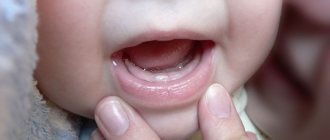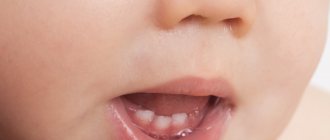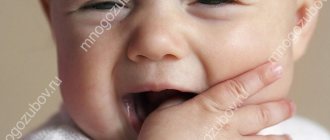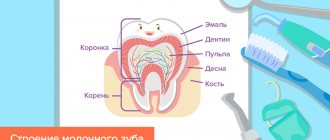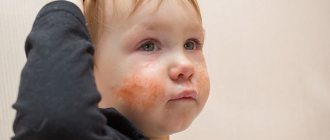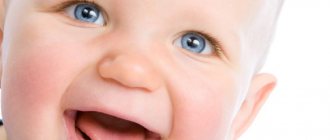It’s rare when a baby’s teething process is easy and painless. Usually, the appearance of teeth in a child is associated with suffering for himself and, of course, for loving parents who cannot find a place for themselves, trying to somehow make the life of the baby easier. Often the symptoms of teething are similar to those of viral and other diseases. Therefore, increased care is required from the mother.
What should parents do if there are signs of teething in their baby? Medicines, ointments, “rodents”? Or should I immediately go to the dentist? First, let's stay calm. Secondly, let’s try to understand what is the reason for the child’s poor health - is it really a matter of teeth?
Before teething
At the time of birth, the child has already formed the rudiments of teeth. But they are not visible because they are located inside the gums. And, nevertheless, the baby’s gums require careful monitoring and care. They must be wiped twice a day with gauze wrapped around your finger. That's enough for now. Such procedures are also useful because the baby gets used to manipulations in his mouth. Later, this will make your life much easier when it’s time to teach your child to brush his teeth or, if you need to look into your baby’s mouth to assess the situation with his teeth and gums.
How to relieve painful sensations
During this period, the baby's growing body undergoes important changes, and the support of adults and their care can significantly alleviate this condition. Firstly, take your child in your arms more often so that he feels supported; tactile contact will further calm and distract him. Secondly, make sure that he drinks the required amount of water - usually the baby begins to refuse the bottle, just feed him from a spoon.
You can put the baby to your chest to calm him down, do not forget about massaging the gums, which is best done using a special attachment on your finger.
What to use
If basic techniques do not save the situation, you should resort to auxiliary options. If the pain is very intense, try local anesthesia. For this purpose, special gels containing benzocaine/lidocaine are suitable, which are applied directly to the gums several times a day. They have a short-term effect and are safe for a small organism, but it is still recommended to consult a specialist first.
Preparations based on ibuprofen or paracetamol are good for relieving fever. You can take it several times a day, the drugs fight high fever and partially relieve pain.
But you shouldn’t ignore folk recipes either; it will be useful to make infusions of mint, chamomile, lavender, and sage. The resulting substance is impregnated with a cotton pad, which must be used to wipe soft tissues. You can also replace the infusion with a soda solution; this will require a glass of boiled water and 1 teaspoon of baking soda.
Additional Methods
At an early stage of life, it is especially important to support the child, since any load on the small body is felt very acutely. A special reaction to teething requires a special drug, for example, Dentokind copes well with all symptoms - it provides analgesia, an anti-inflammatory, calming effect, and sleep stabilization.
To satisfy your child’s craving to put various objects in his mouth and at the same time alleviate his condition, buy a special rubber ring, which is placed in the freezer for a short time for cooling and given to the child.
Perhaps the baby will not like such a ring, then watch what he likes. The main thing is that the objects do not have sharp corners and cannot damage the gums, for example, it could be a bagel or a bread crust.
Try to distract your child as much as possible, switch his attention to a game or an interesting cartoon. Daily walks will also help if you don’t have a fever and your condition allows it.
Category Children Published by Mister stomatolog
When does a baby cut teeth?
Usually the first tooth makes itself felt when the baby is 6-7 months old. In some cases (for example, if mothers relied heavily on cottage cheese during pregnancy), they may appear a month or two earlier than expected. Sometimes, on the contrary, the teeth are a little late.
Regardless of the number of teeth that have come out by the age of one year, at this age the baby will definitely need to be shown to the dentist. The doctor will examine the child’s oral cavity, give parents advice on care, and recommend the most suitable remedies.
Scheme of baby teeth eruption
All children are unique.
There is no exact timetable for how their smile should go from toothless to full. According to statistics, most children develop their first incisor at the age of six months. But there is nothing to worry about if this happens earlier. Moreover, doctors know of many cases where a newborn already had one or more teeth in his mouth. A later eruption is also considered a variant of the norm - at eight to eleven months. Even in twins, the incisors may appear slightly apart.
When the first tooth “comes out” depends on:
- hereditary predisposition;
- health conditions;
- nature of nutrition;
- climatic conditions;
- the period of pregnancy at which the child was born (in premature babies, many processes occur with a large delay, and there is nothing wrong with that).
The lower incisors may appear together or separately. Soon after them, the upper ones “hatch”. The lateral units are cut in the same sequence - first from below, and then from above.
Typically, by the time your baby is first born, she already has eight teeth. The rest are shown a little later. But, if in one year the child remains completely toothless, while he develops in accordance with age norms, there is no need to worry - everything has its time.
After the incisors come the fangs, then all the rest. This is the order that is considered normal. Here is a standard scheme for cutting through milk units:
- 6-7 months - central incisors of the lower jaw;
- 8-9 months - incisors in the center of the upper jaw;
- 9-11 months - lateral incisors on top;
- 11-13 months - lateral incisors from below;
- 12-15 months - upper and lower first molars;
- 18-20 months - fangs;
- 20-30 months - second molars of the upper/lower jaw.
Once again, we draw the attention of caring parents to the fact that the indicated periods are average. It is not at all necessary that everything happens according to such a plan for a child.
How do babies cut teeth?
The symptoms of teething are approximately the same for all infants. In some children they are more pronounced, in others - less. Rarely do teeth come out “on their own,” usually with a whole “bouquet” of various accompanying phenomena. Among them:
- Redness, swelling of the gums. In some cases - quite severe irritation and bleeding.
- Excessive salivation also indicates that a new tooth is on the way.
- The gums itch and itch. But the child cannot say for himself that he is experiencing discomfort. The baby's new habit will tell him about this problem - pulling various hard objects into his mouth to scratch his gums.
- When teething begins, the baby becomes more capricious than usual. This is understandable, because the baby experiences discomfort and tries to attract the attention of elders to his trouble.
- The baby has trouble falling asleep and often wakes up. Pain and itching interfere with restful sleep.
- Lack of appetite is also typical during teething. The baby has no time to eat.
- Weakness, general malaise.
- A child's temperature during teething can rise to 39 degrees. This is due to local irritation of the gums. The temperature can “jump”, either rising or falling, or rise to a certain level and remain for several days. In any case, an elevated temperature in an infant is a serious cause for concern. It needs to be monitored and measured as often as possible. If the high temperature persists for more than two days, you should call a doctor.
- Intestinal upset, cough, runny nose.
- Sometimes, when teething, a rash may appear on the baby's skin. If the cause is teeth, the rash usually appears on the chin. This is due to increased salivation. The rash may also appear on other parts of the face: on the cheeks, near the nose. At one time I was very alarmed by my son’s hot cheeks. As the doctor said, this sometimes occurs during teething.
- It happens that teething in a child is accompanied by vomiting. If the baby vomits 1-2 times during the day, perhaps it really is a matter of teeth. However, we can also talk about an infectious disease. If a child often vomits, the problem is most likely no longer in the teeth and urgent measures need to be taken.
- Teething is often accompanied by stomatitis. The fact is that at this time the baby is especially inclined to put any objects into his mouth in order to “scratch” his gums. It is difficult to keep track of all the things that end up in the hands of a toddler. Therefore, it happens that along with insufficiently clean hands or toys, an infection causing stomatitis enters the baby’s mouth. The disease manifests itself in the form of small painful ulcers in the mouth. Stomatitis brings a lot of unpleasant sensations to the baby - pain, fever, loss of appetite. This, of course, cannot be ignored.
Help a child
When negative symptoms develop, which bring a lot of discomfort to the child, lack of appetite and sleep, therapy is recommended. It should be gentle so as not to harm the body at an early age.
Elimination of elevated temperature
If a child’s body temperature rises and remains at 38°C or higher, give one of the following medications:
- Nurofen;
- Cefekon D;
- Children's Paracetamol;
- Panadol.
In total, there are 2 active ingredients with different properties:
- Paracetamol
. The volume of active substance is calculated based on the child’s body weight. The maximum daily dose is 60 mg per 1 kg of body weight. Take before meals for a quick effect. If you need to calculate a single dose, calculate 15 mg per kilogram of body weight. After taking an antipyretic drug, the next dose can be taken no earlier than 4 hours later. Young patients are given drugs in the form of syrups. They have a sweet taste, so the child swallows them without problems. If the body temperature is too high, it is recommended to give suppositories. The active substance is quickly absorbed through the intestinal mucosa, so the temperature drops faster. - Ibuprofen
. This is a more potent substance, so 6-8 hours should pass between doses. Only 3 doses are allowed to be given in 1 day. Calculation is made for 1 dosage from the ratio of 10 mg of the drug per kilogram of the child’s body weight. If you need to calculate the daily dose, use a ratio of 30 mg of the drug per kilogram of body weight.
If side effects occur, you must stop taking the drug. Any type of negative reaction that could lead to a deterioration in the baby’s well-being is not acceptable.
Antipyretic drugs are recommended to be used after a general examination of the baby and anamnesis. This is what the pediatrician does.
Treatment of a runny nose
For the treatment of a runny nose, the following gentle remedies are recommended, which are allowed for children from birth:
- Derinat;
- Nazivin baby;
- Aqua Maris.
Nasal drops are used only as a last resort, as they are vasoconstrictor drugs. The maximum intake should be no more than 5 days.
Pain in gums
The table shows the optimal drugs for eliminating pain in the gums.
| A drug | Characteristic |
| Kalgel | Apply a small amount of gel to the gums. Application is carried out for no more than 6 days. Allowed to be applied 4-5 times a day |
| Kamistad baby | You can use a cotton swab or your fingers to apply the product. Reception is carried out no more than 3 times a day |
| Holisal | Soft tissues are pre-wiped with a cotton pad and rubbed in 3 times a day. |
To make teething easier, special toys are provided. They are called teethers. It is recommended to pre-treat them with boiling water to prevent the spread of bacterial microflora.
During teething it is not recommended to wean. This will be very stressful for the child. Breastfeeding helps him calm down.
What to do if your baby is showing signs of teething?
First of all, carefully monitor the condition of the baby and measure the temperature more often. If necessary, knock it down using means approved for infants. To relieve discomfort in the gums, special teethers will help; it is best to use products with a cooling gel. Cold acts as a natural pain reliever. If the baby experiences severe discomfort, it hurts, he cries, he is capricious, you can buy a special children's gel for the gums. It cannot be used constantly, only in exceptional cases. Before use, be sure to read the instructions.
***
Signs of teething can easily be confused with a viral or infectious disease. Sometimes, in order to understand what’s wrong with the baby, you need to show the baby to the doctor. Moreover, during teething, the baby’s weakened body is more vulnerable to colds and other ailments. There is no need to definitely attribute all the baby’s ailments to teeth. The reason may be completely different.
How to relieve symptoms
The basic principle of medicine is to do no harm. Therefore, the first thing you need to do is consult a doctor. You cannot select medications on your own or on the advice of neighbors. And in the pharmacy you can find a lot of ointments and gels with a “cooling” effect and remedies for fever.
Teethers
There are different types of devices. Some of them are used for signs of eruption of the upper teeth, others are suitable for the frontal units or distant molars. The purpose of use is to massage the gums, which alleviates the condition of the little one. You can buy silicone and latex products that are suitable for children as young as 3 months. If mom will massage her gums, she needs a fingertip with a special brush. To help the baby scratch his teeth and play at the same time, special rattles have been created. Teethers for yearlings can be filled with gel or water. They cool the oral cavity well, which “freezes” the pain. The device may vibrate if the baby bites it.
Cream
It is used as a protective agent at the time of increased salivation. This protects the skin of the chin and chest from irritation, especially during a walk in winter.
Vertical position
Parents need to play with their baby more often and distract him from pain. Holding your child upright will reduce pain by reducing blood flow to the head.
Drinking regime
Salivation, especially increased salivation, provokes severe thirst. You need to give your baby more clean water.
Psychological discomfort is compensated by affection, care, and attention. At this time, you should not introduce new foods into the diet, so as not to expose the baby to additional stress.


